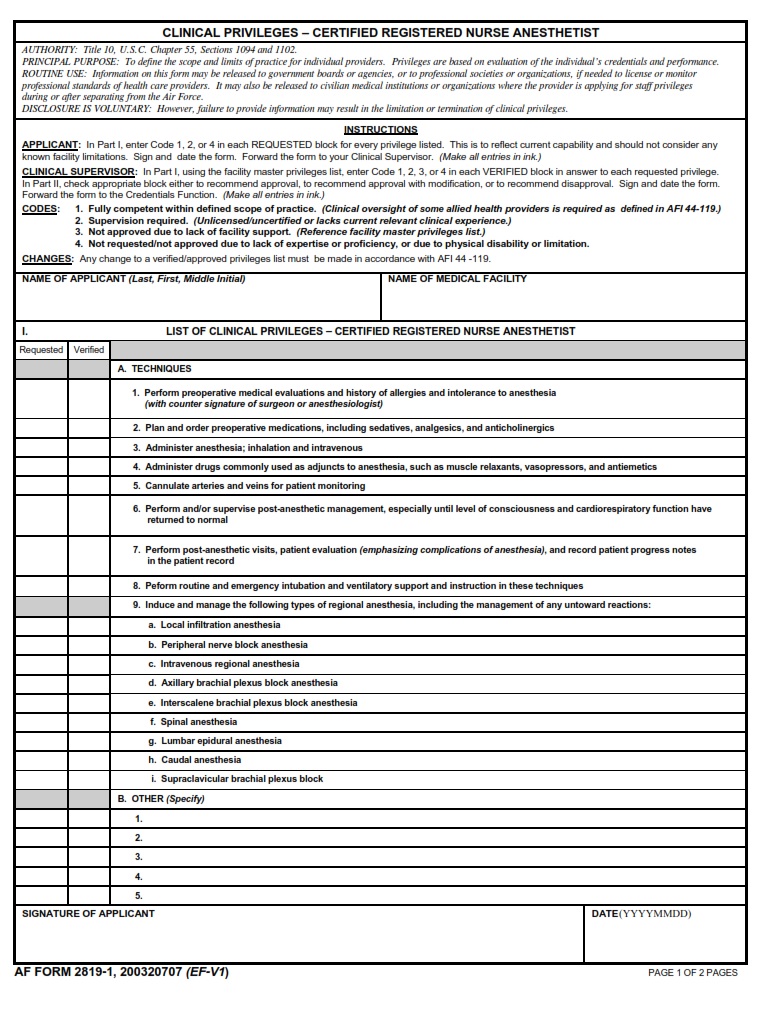AF-FORMS.COM – AF Form 2819-1 – Clinical Privileges – Certified Registered Nurse Anesthetist – Is there anything more nerve-wracking than going under the knife? Whether it’s a routine procedure or a complex surgery, the thought of being put to sleep and trusting your life in the hands of medical professionals can be anxiety-inducing. That’s why having highly skilled Certified Registered Nurse Anesthetists (CRNAs) is crucial in any healthcare setting. These specialized nurses are trained to administer anesthesia safely and effectively during surgical procedures, ensuring patients are comfortable and pain-free throughout their time in the operating room. In this article, we will explore the importance of AF Form 2819-1 – Clinical Privileges for CRNAs and how it plays a vital role in granting these healthcare heroes the authority to deliver exceptional care. Strap on your scrubs, because we’re diving into the world of anesthesia expertise!
Picture this: you’re lying on an operating table, moments away from undergoing surgery that could potentially change your life. As you take deep breaths through an oxygen mask, you feel a sense of calm wash over you. Why? Because right beside you stands a Certified Registered Nurse Anesthetist (CRNA), ready to guide you through this daunting process with expertise and precision. These unsung heroes play an integral role in delivering safe anesthesia care, ensuring patients remain stable throughout surgical procedures by carefully monitoring vitals and adjusting medication dosages as needed. Join us as we delve into AF Form 2819-1 – Clinical Privileges for CRNAs – the gateway that grants them authority to work their magic in one of medicine’s most critical fields: anesthesia administration!
Download AF Form 2819-1 – Clinical Privileges – Certified Registered Nurse Anesthetist
| Form Number | AF Form 2819-1 |
| Form Title | Clinical Privileges – Certified Registered Nurse Anesthetist |
| Edition Date | 3/4/2005 |
| File Size | 247 KB |
AF-Form-2819-1-Clinical-Privileges-–-Certified-Registered-Nurse-Anesthetist.pdf (17 downloads )
What is an AF Form 2819-1?
The AF Form 2819-1 is a vital document in the realm of healthcare, specifically for Certified Registered Nurse Anesthetists (CRNAs). This form serves as the certification record for CRNAs’ clinical privileges within the United States Air Force. It outlines their authorized scope of practice and demonstrates their competence in providing anesthesia services.
What makes the AF Form 2819-1 unique is its ability to capture both the educational background and experiential qualifications that CRNAs possess. The form evaluates factors such as education, training, experience, and professional activities to determine competency levels. Its comprehensive nature ensures that only highly qualified individuals receive this certification, guaranteeing safe and effective anesthesia delivery across military medical facilities.
Moreover, the AF Form 2819-1 goes beyond just listing credentials; it recognizes the evolving role of CRNAs within modern healthcare systems. As advanced practice nurses specializing in anesthesia care, they bring a unique skill set to patient management. This form acknowledges their expertise by granting them specific clinical privileges tailored to their capabilities. In doing so, it empowers CRNAs to provide high-quality care in collaboration with other healthcare professionals.
Overall, the AF Form 2819-1 holds immense significance for CRNAs within the Air Force medical community. It not only regulates their scope of practice but also highlights their valuable contributions to patient care and safety. By acknowledging their expertise through this certification process, it ensures that military healthcare facilities are staffed with highly skilled professionals capable of
Where Can I Find an AF Form 2819-1?
Are you a Certified Registered Nurse Anesthetist (CRNA) and wondering where you can find the AF Form 2819-1? Look no further! This important document is available on the Air Force Medical Service (AFMS) website. It plays a crucial role in granting Clinical Privileges to CRNAs, allowing them to provide anesthesia services in military medical facilities.
Accessing the AF Form 2819-1 is simple and convenient. Just visit the AFMS website and navigate to their Forms section. There, you’ll find a comprehensive list of documents used across various medical specialties, including anesthesia. Click on the form number or name to open it in PDF format, making it easily printable for your convenience.
By utilizing this resource, CRNAs can ensure their clinical privileges are properly granted and maintained. This not only ensures compliance with Air Force regulations but also allows CRNAs to continue serving our military members by providing safe and effective anesthesia care. So don’t waste another moment; visit the AFMS website today to find your AF Form 2819-1!
AF Form 2819-1 – Clinical Privileges – Certified Registered Nurse Anesthetist
AF Form 2819-1 plays a crucial role in determining the clinical privileges for Certified Registered Nurse Anesthetists (CRNAs). These skilled professionals bring a unique set of skills to the table, and their roles are expanding as they take on more responsibilities in healthcare settings. The AF Form 2819-1 serves as a tool for evaluating and documenting the level of autonomy and decision-making authority that CRNAs possess.
One interesting aspect of AF Form 2819-1 is its ability to capture the specific privileges granted to CRNAs based on their qualifications, experience, and training. This form goes beyond simply stating whether an individual has been granted privileges or not; it delves into the specifics of what these privileges entail. From intubation to pain management techniques, this form details each privilege with precision, ensuring that CRNAs have clarity regarding their scope of practice.
Moreover, AF Form 2819-1 enables healthcare facilities to maintain efficient workflows by clearly delineating which procedures and interventions can be independently performed by CRNAs without direct supervision from physicians. This document aids in streamlining patient care processes while allowing for collaborative efforts between nurses and physicians when necessary. By outlining clinical privileges in such explicit detail, this form ensures accountability while promoting collaboration between different members of the healthcare team.

